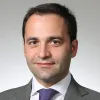Kalin Anev Janse in interview with L'AGEFI (France)
Kalin Anev Janse, ESM Secretary General
Interview with L’AGEFI (France)
Published on 12 March 201
Interviewer: Patrick Aussannaire
L’Agefi: What are your funding goals for 2018?
Kalin Anev Janse: Over the course of 2018, the EFSF (European Financial Stability Facility) and the ESM (European Stability Mechanism) are expected to issue a total of €46 billion euros in medium and long-term bonds: €28 billion for the former, and €18 billion for the latter. The ESM lowered its funding needs for this year to take into account Spain's early repayment of €5 billion. It is the seventh time Spain will make an early repayment of its loan, which was used to recapitalise its banks in 2012 and 2013. Even with the reduction in 2018, the ESM's financing needs are still €6.5 billion more than 2017. For the EFSF, nothing changed this year. Overall, the EFSF needs €21 billion less funding compared to last year. Taking everything into account, 2018 will still be our fourth-biggest issuance volume. In 2019, we estimate to issue €32.5 billion under both institutions.
How do you guarantee the liquidity of the ESM securities?
We estimate that the ECB holds €103.5 billion of our bonds under its buy-back programme, or 44% of the total amount outstanding. Still, secondary market trade volumes soared to more than €50 billion per quarter in 2017, with ticket sizes of €20-50 million being the most popular. We closely monitor the behaviour of investors in the primary and secondary market through our proprietary quantitative and qualitative data system. We can see when liquidity in a bond is drying out. And we can also measure changing investor behaviour over time. For example, the decline in yield since the introduction of the ECB's bond buy-backs led to a reduction in the exposure to ESM bonds by Asian investors, but this was offset by the strong appetite from European investors.
What feedback do you receive from investors?
The ESM is the only institution that permits one to buy a blended credit euro area exposure. The euro area has become attractive for international investors again because it is considered more stable than the United States and the United Kingdom, now that a risk of break-up of the euro zone seems to have disappeared completely. The first US dollar issue of the ESM carried out last year further diversified our investor base to North and South America. We plan to continue issuing in dollars at a rate of one or two deals per year over the next few years. For the time being, however, we do not plan to extend this approach to other currencies. Our stock of bonds will gradually shrink over time, as long as there is no need for new programmes, or new mandates granted to the ESM.
Will the possible end of ECB buy-backs have an impact on the ESM?
The ECB’s quantitative easing has so far enabled the five states (Greece, Portugal, Ireland, Spain, and Cyprus) that have been supported by the ESM to benefit from attractive financing conditions. A reduction in yield levels meant we could charge them lower fees and therefore the cost to service debt went down for these countries. A change in ECB policy will have an equal effect in the market and the ESM will just be one of the players to navigate this change. There are upsides as well: a rise in rates allows to attract more non-European investors to ESM bonds, as they are looking for higher yields.
What will be your role in the coming years?
On the topic of deepening of Economic and Monetary Union, we see an emerging consensus that the ESM should provide the backstop to the Single Resolution Fund. Also, there seems to be support for an enhanced role for the ESM in crisis management, which could include negotiating and monitoring financial support programmes. This would happen in tandem with the European Commission and with full respect of the Commission’s competencies. An enhanced role of the ESM would make monetary union more robust, and the ESM could build on the expertise that it has acquired with its five financial assistance programs since 2011. But of course, it is up to the euro area member states to precisely define our future functions. I expect that a lot more will become clear on this in the coming half year.
Author

Contacts


